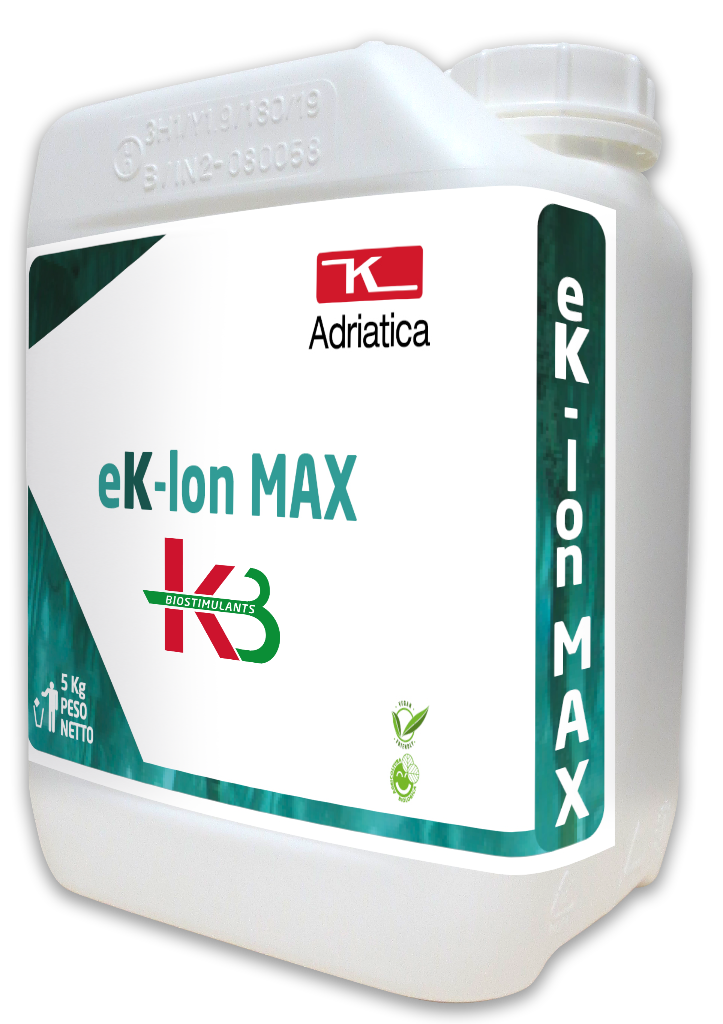

Packaging 5 kg
PHYSIOLOGICAL ACTIVATORS
eK-lon MAX
IMPROVES STRESS RESISTANCE
ek-lon MAX is an extract of the fronds of the Ecklonia maxima seaweed. The extract has biostimulant properties that make plants and crops more tolerant to environmental stress, particularly drought. Ek-lon MAX is produced only with fronds and at a controlled temperature. This process preserves all bioactive components such as polysaccharides, polyphenols and natural hormones. All these compounds act together to stimulate root growth which in turn improves the absorption of water and nutrients with beneficial effects on water and thermal stress. The applications of ek-lon MAX both foliar and via fertigation protect crops from stress with positive effects on yield and product quality
| Culture | Time of application | Dose fogliare* | Fertigation dose* |
|---|---|---|---|
| Fruiting vegetables (Watermelon, Cucumber, Eggplant, Melon, Pepper, Tomato, Zucchini, Pumpkin) | In the nursery: apply on the seedlings once a week for 2-3 times, soak the seedling tray in a 1: 100 solution before transplanting In the field: starting from 15 days after the transplanting, 2-4 applications at intervals of 15 days |
200-300 g/hl | 3-6 kg |
| Other vegetables (Garlic, Broccoli, Carrot, Cabbage, Cauliflower, Onion, Fennel, Leek) | In the nursery: apply on the seedlings once a week for 2-3 times, soak the seedling tray in a 1: 100 solution before transplanting In the field: starting from 15 days after the transplanting, 2-4 applications at intervals of 15 days |
200-300 g/hl | 3-6 kg |
| Leafy vegetables (Chicory, Lettuce, Radicchio, Rocket, Escarole, Celery, Spinach) | In the nursery: apply on the seedlings once a week for 2-3 times, soak the seedling tray in a 1: 100 solution before transplanting In the field: starting from 15 days after the transplanting, 2-4 applications at intervals of 15 days |
200-300 g/hl | 3-6 kg |
| Olive e Grapes | 3 applications: buds of 5-10 cm, pre-flowering, grape/drupe of 4-6 mm diameter | 300-400 g/hl | 4-8 kg |
| Kiwifruit | 3-4 applications: from pre-flowering, to be repeated every 15 days | 300-400 g/hl | 4-8 kg |
| Citrus (Orange, Bergamot, Clementine, Lemon, Tangerine) | 3-4 applications: from pre-flowering, to be repeated every 10-14 days | 300-400 g/hl | 4-8 kg |
| Pome fruits (Quince, Apple, Pear) | Pre-flowering, petals' fall, fruit enlargement starting from 20 mm diameter: applications every 10-15 days | 300-400 g/hl | 4-8 kg |
| Stone fruits (Apricot, Cherry, Nectarine, Peach, Plum) | 4-6 applications: from flowering to veraison (change of color), every 15 days | 300-400 g/hl | 4-8 kg |
| Strawberries | Soak the seedlings in a 1: 100 solution before transplanting From the beginning of flowering: 2-3 applications at intervals of 15-20 days | 300-400 g/hl | 4-8 kg |
| Nut fruits | From flowering of the female inflorescence: 3-5 applications every 15 days | 300-400 g/hl | 4-8 kg |
| Legumes (Bean, Lentil, Pea) | 4 applications: 3 to 5 leaves, pre-flowering, full flowering and at pod's development | 200-300 g/hl | 3-6 kg |
| Small fruits (Raspberry, Blueberry, Blackberry, Currant) | From pre-flowering, 3-4 applications to be repeated every 7-10 days | 200-300 g/hl | 3-6 kg |
-
Fruiting vegetables (Watermelon, Cucumber, Eggplant, Melon, Pepper, Tomato, Zucchini, Pumpkin)200-300 g/hl3-6 kgIn the nursery: apply on the seedlings once a week for 2-3 times, soak the seedling tray in a 1: 100 solution before transplanting
In the field: starting from 15 days after the transplanting, 2-4 applications at intervals of 15 days -
Other vegetables (Garlic, Broccoli, Carrot, Cabbage, Cauliflower, Onion, Fennel, Leek)200-300 g/hl3-6 kgIn the nursery: apply on the seedlings once a week for 2-3 times, soak the seedling tray in a 1: 100 solution before transplanting
In the field: starting from 15 days after the transplanting, 2-4 applications at intervals of 15 days -
Leafy vegetables (Chicory, Lettuce, Radicchio, Rocket, Escarole, Celery, Spinach)200-300 g/hl3-6 kgIn the nursery: apply on the seedlings once a week for 2-3 times, soak the seedling tray in a 1: 100 solution before transplanting
In the field: starting from 15 days after the transplanting, 2-4 applications at intervals of 15 days -
Olive e Grapes300-400 g/hl4-8 kg3 applications: buds of 5-10 cm, pre-flowering, grape/drupe of 4-6 mm diameter
-
Kiwifruit300-400 g/hl4-8 kg3-4 applications: from pre-flowering, to be repeated every 15 days
-
Citrus (Orange, Bergamot, Clementine, Lemon, Tangerine)300-400 g/hl4-8 kg3-4 applications: from pre-flowering, to be repeated every 10-14 days
-
Pome fruits (Quince, Apple, Pear)300-400 g/hl4-8 kgPre-flowering, petals' fall, fruit enlargement starting from 20 mm diameter: applications every 10-15 days
-
Stone fruits (Apricot, Cherry, Nectarine, Peach, Plum)300-400 g/hl4-8 kg4-6 applications: from flowering to veraison (change of color), every 15 days
-
Strawberries300-400 g/hl4-8 kgSoak the seedlings in a 1: 100 solution before transplanting From the beginning of flowering: 2-3 applications at intervals of 15-20 days
-
Nut fruits300-400 g/hl4-8 kgFrom flowering of the female inflorescence: 3-5 applications every 15 days
-
Legumes (Bean, Lentil, Pea)200-300 g/hl3-6 kg4 applications: 3 to 5 leaves, pre-flowering, full flowering and at pod's development
-
Small fruits (Raspberry, Blueberry, Blackberry, Currant)200-300 g/hl3-6 kgFrom pre-flowering, 3-4 applications to be repeated every 7-10 days
In the case of different volumes, for use with low-volume or volume recovery sprayers, where, for proper wetting of the vegetation, a smaller quantity of water than the Normal Volumes (VN) may be sufficient, it is suggested to refer to the dose of 200-400 gr per hectolitre (gr/hL).







